With approximately 10,000 bird species decorating our planet, the avian world is incredibly diverse. When we talk about size in birds, it often leads to interesting debates. Is it about length, weight, or perhaps the volume they occupy? For creatures of the air, it seems most fitting to consider their grandeur by how much of the sky they command as they soar – their wingspan.
This article explores the largest flying birds based on wingspan, while also acknowledging some of the impressive heavyweights in the avian class. We’ve compiled a list considering wingspan, weight, and diversity, deliberately excluding very similar species to keep it engaging and informative, rather than a repetitive list of near-identical vultures, pelicans, and albatrosses.
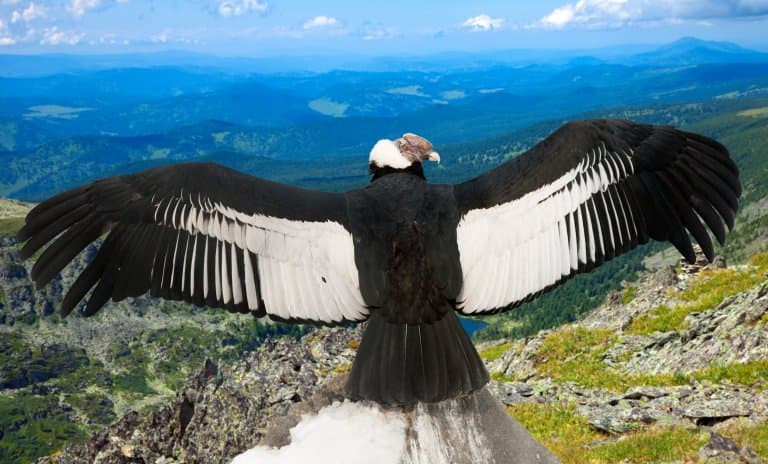 Andean Condor majestically soaring
Andean Condor majestically soaring
Here are the top ten largest flying birds in the world, ranked by wingspan and enriched with details about their weight and unique attributes.
10. Blakiston’s Fish Owl (Wingspan: 1.8 m / 6 ft)
Weight: 4.6 kg / 10 lb
The Blakiston’s fish owl, a rare and magnificent eagle owl inhabiting East Asia and Russia, stands as a contender for the largest owl species alongside its cousin, the Eurasian eagle owl. Both boast impressive wingspans reaching around 1.8 meters (6 feet) and sometimes slightly more. While the Eurasian eagle owl might claim the absolute record wingspan, the Blakiston’s fish owl edges it out on average. Given their smaller global population, the Blakiston’s fish owl rightfully earns its place among the giants. These owls are not only large but also ecologically significant, preying on fish in riparian habitats, making them indicators of healthy freshwater ecosystems.
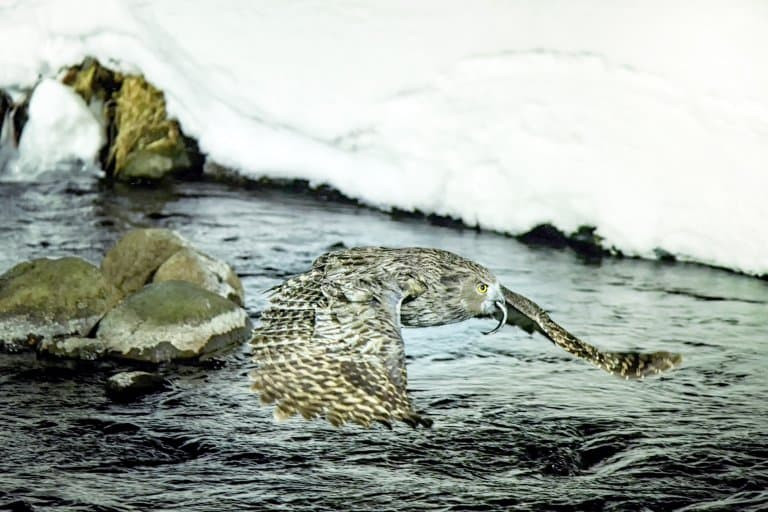 Blakiston's Fish Owl perched on a branch
Blakiston's Fish Owl perched on a branch
9. Dalmatian Pelican (Wingspan: 1.9 m / 6.2 ft)
Weight: 15 kg / 33 lb
The Dalmatian pelican is not just the largest of the pelicans; it is also among the largest of all birds. Characterized by its enormous pouch and a wingspan nearing two meters, it significantly surpasses its canine namesake in size. These birds, while not particularly graceful in appearance, can weigh up to 15 kg (33 lbs), classifying them as one of the heaviest flying birds. Despite some exaggerated claims about their wingspan rivaling the largest on this list, verified measurements place them slightly lower. However, with average wingspans reaching 1.9 m and anecdotal reports of up to 2.8 m, the Dalmatian pelican remains undeniably one of the largest birds dominating the skies, often seen in and around wetland habitats across Eurasia.
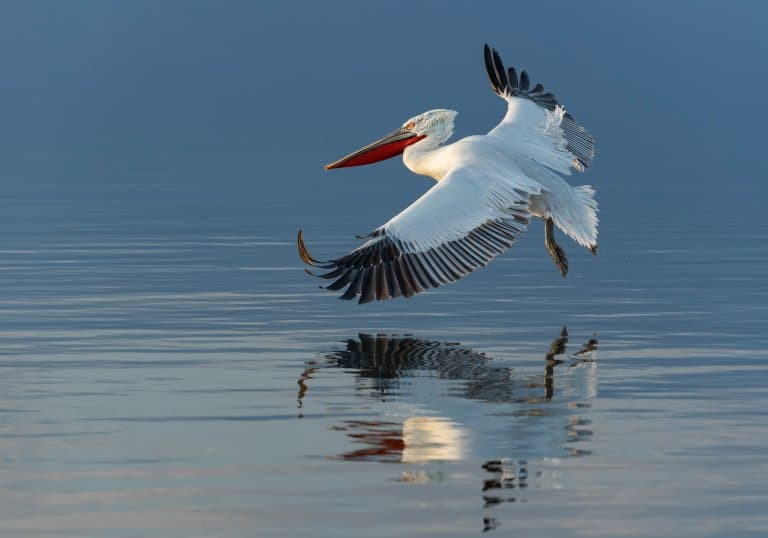 Dalmatian Pelican swimming in water
Dalmatian Pelican swimming in water
8. Secretarybird (Wingspan: 2.1 m / 6.9 ft)
Weight: 4.27 kg / 9.4 lb
The secretarybird, with its striking appearance, seems almost like a creature from a prehistoric era, resembling a living dinosaur more than a typical bird. Standing tall at up to 1.3 meters, it’s not only tall but also possesses a substantial wingspan. However, its body structure isn’t optimally designed for flight, leading it to primarily rely on wind currents for lift. Flapping flight is usually brief, and this bird spends most of its time on the ground, striding through grasslands hunting snakes and other prey with its powerful legs. Their terrestrial lifestyle and impressive size make them a unique and fascinating bird of prey found in the African savannas.
 Secretarybird in flight showing its wingspan
Secretarybird in flight showing its wingspan
7. Steller’s Sea Eagle (Wingspan: 2.3 m+ / 7.5 ft)
Weight: 10 kg / 22 lb
As we enter the realm of eagles, conflicting reports and national pride often cloud the facts. Eagles, symbols of power and majesty, are subject to much admiration and, at times, exaggerated claims of size. Among the contenders for the title of “largest eagle” are the Steller’s sea eagle (Russia), Harpy eagle (Central and South America), Philippine eagle, and the Bald and Golden eagles (North America). While various eagles are claimed to have wingspans exceeding 2.4 m (8 feet), verifiable data is scarce. The Steller’s sea eagle is often recognized as the heaviest eagle, which contributes to its ranking here. These apex predators are crucial to their ecosystems, and their large size reflects their dominance in their respective habitats, typically coastal regions of Northeast Asia for Steller’s sea eagles.
 Steller's Sea Eagle perched on a snowy branch
Steller's Sea Eagle perched on a snowy branch
6. Trumpeter Swan (Wingspan: 2.4 m / 7.9 ft)
Weight: 15 kg / 33 lb
Moving into the heavyweights, the Trumpeter swan stands out as the largest waterfowl and is heavier than many birds on this list. Native to North America, they are larger and more vocal than their European swan relatives. Their imposing size offers them protection from most predators, except for humans. Trumpeter swans enjoy relatively peaceful lives, often living for over 30 years. Juveniles thrive on protein-rich insects, while adults maintain a primarily vegetarian diet. Their conservation story is also remarkable, having recovered from near extinction to healthy populations through dedicated efforts.
 Trumpeter Swan swimming in a lake
Trumpeter Swan swimming in a lake
5. Kori Bustard (Wingspan: 2.47 m / 8.1 ft)
Weight: 18 kg / 39 lb
The Kori bustard is arguably the heaviest flying animal and also boasts one of the largest wingspans. Similar to the secretarybird, it is capable of flight but prefers terrestrial life, foraging for food on the ground and even engaging in territorial disputes with secretarybirds. Weight estimates sometimes reach 20 kg, but 18 kg is a reliably reported figure. Standing over a meter tall, its bulk serves as a defense mechanism. These birds inhabit the dry savannas and grasslands of Africa and are known for their elaborate courtship displays.
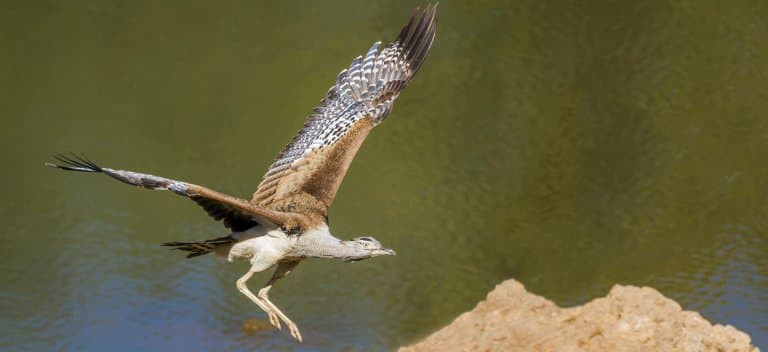 Kori Bustard standing in grassland
Kori Bustard standing in grassland
4. Marabou Stork (Wingspan: 2.9 m / 9.5 ft)
Weight: 9 kg / 20 lb
The Marabou stork, as tall as the secretarybird but much more adept at flying, is an imposing scavenger of East Africa. Often found around human settlements, they forage through waste, casting large shadows as they approach. While some claim their wingspan exceeds 3 meters, possibly rivaling the Andean condor, solid evidence is still lacking. Nonetheless, they are undoubtedly among the largest flying birds. With a height of 1.2 m and a wingspan close to 2.9 m, marabou storks are truly giants. Though perhaps lacking the aesthetic appeal of condors, they possess a unique, if somewhat ungainly, charm.
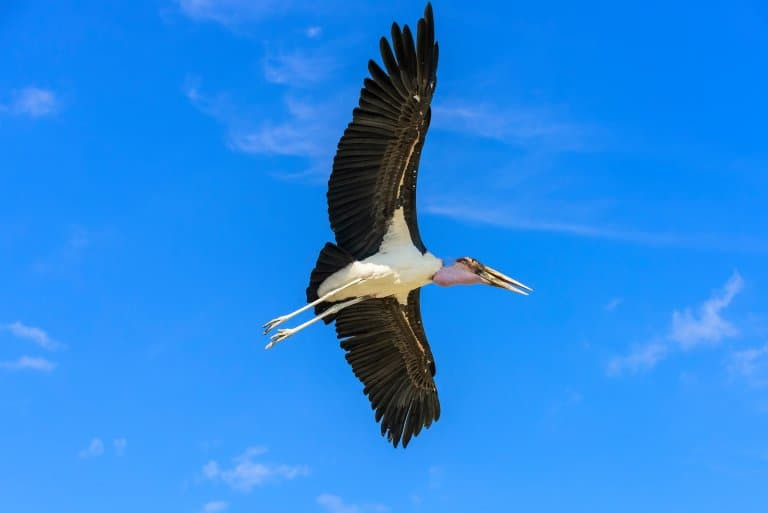 Marabou Stork with large wingspan in flight
Marabou Stork with large wingspan in flight
3. Andean Condor (Wingspan: 3 m / 9.8 ft)
Weight: 16 kg / 35 lb
The Andean condor generally outclasses most other flying birds in both average weight and wingspan, making it, on average, the largest flying bird in the world. While male Kori bustards can sometimes outweigh them, and exceptionally large individuals of other species might surpass their wingspan, the Andean condor maintains its position as the largest on average. Their massive wing area allows them to soar effortlessly for hours, conserving tremendous energy. As the largest flying bird in the Western Hemisphere, the Andean condor is a symbol of the Andes Mountains and plays a vital role in its ecosystem as a scavenger.
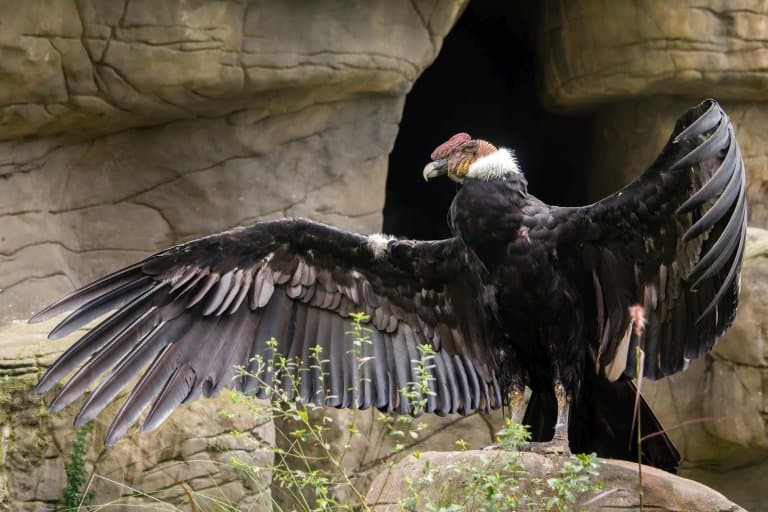 Andean Condor in flight, wings spread wide
Andean Condor in flight, wings spread wide
2. Cinereous Vulture (Wingspan: 3 m / 9.8 ft)
Weight: 13 kg / 29 lb
The Cinereous vulture, another impressive raptor, faces close competition from the Himalayan vulture in terms of wingspan. While determining the absolute largest is challenging, the Cinereous vulture, also known as the Black vulture, is the largest Old World vulture and a significant bird of prey. Its range extends from Spain across Europe, the Middle East, and Asia. These long-lived birds, capable of reaching 40 years, have faced population declines due to poisoning and habitat loss in parts of Europe but are subject to successful reintroduction programs. Though primarily scavengers, they are powerful birds capable of taking larger prey when necessary.
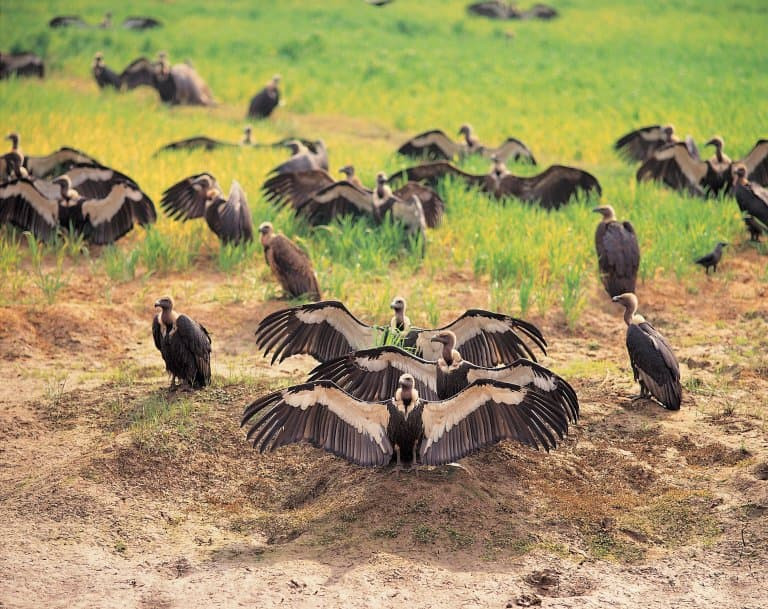 Cinereous Vultures perched on rocks
Cinereous Vultures perched on rocks
1. Wandering Albatross (Wingspan: 3.2 m / 10.5 ft)
Weight: 12 kg / 26 lb
The Wandering albatross stands out as the undisputed champion of wingspan among living birds. While other albatross species come close, the Wandering albatross consistently measures around 3.2m, with credible reports reaching up to 3.5 meters. Guinness World Records even lists a specimen with a staggering 3.63m (11 ft 11 in) wingspan. These pelagic giants are masters of long-distance flight, capable of traversing over 120,000 km in a year and 900 km in a single day, spending most of their lives airborne, only landing to breed and feed. Their extraordinary wingspan is perfectly adapted for their life at sea, making them the largest flying bird in terms of wingspan, and a true marvel of avian evolution.
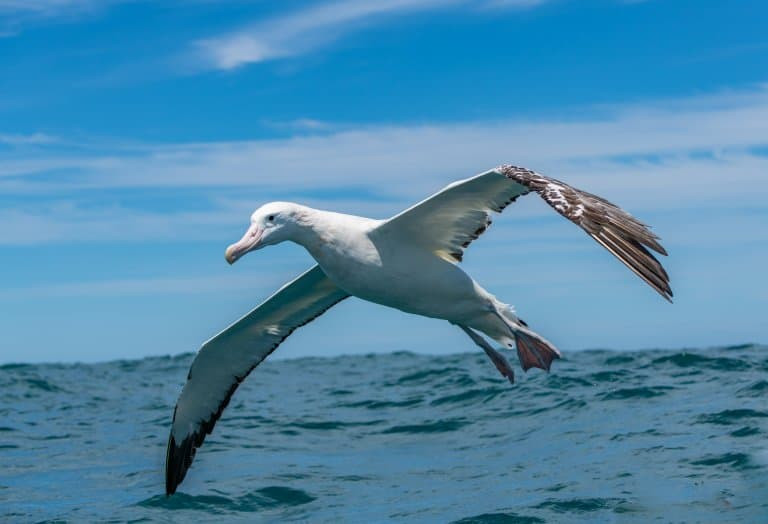 Wandering Albatross gliding over the ocean
Wandering Albatross gliding over the ocean
Final Thoughts
This list details the largest flying birds in the world by wingspan that grace our skies today. But the question remains: does size truly matter? For enthusiasts, bird size can be a source of fascination and admiration. For scientists, however, size is a crucial metric for understanding species and their ecological roles.
Measurements of size allow researchers to infer vital aspects of a bird’s biology, including sex, dietary habits, energy requirements, and their contribution to nutrient cycling within ecosystems. Interestingly, while in most bird species males are larger, raptors like eagles and vultures often exhibit reverse size dimorphism, where females are larger than males, a phenomenon still under scientific investigation.
It’s important to remember this list focuses on flying birds, excluding flightless giants like the ostrich and southern cassowary. Flightless birds, though representing a small fraction of bird species, often evolve to larger sizes due to the absence of flight constraints, prioritizing body mass and density over wingspan. The heaviest birds in the world are indeed flightless, demonstrating that when the sky is not the limit, avian size can reach truly monumental proportions.